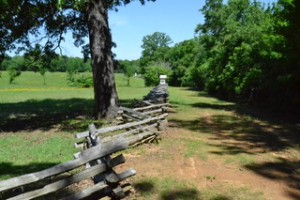For some, the Battle of Shiloh seems like something out of the distant past. For those who study the American Civil War, it is almost a household name. At the same time the battle was in one of the most remote destinations in Southwestern Tennessee. It is one of many battlefields, that while marked by monuments, even monuments that were placed as recently as 2012, the park is one of the most remarkably diverse places one might see.
It is down a small state highway in Tennessee that one travels in order to get to the battlefield. As one enters the gates it is like taking a step back to an earlier time. A time that begs not to be forgotten.
In a visit to the historic battlefield we find the beauty of the place all over once again. It is in the passing of currents of the Tennessee River, a river that flows to the North rather than to the South. It was the one place that Sherman was able to put troops on dry ground.
Sherman had been encouraged to go upriver and try to fight through and break the Memphis and Charleston Railroad somewhere in the vicinity of Corinth, Mississippi. It was during this process that Sherman had happened across this location to put troops on land.
 It was early in the spring of 1862 where one day it would be warm and sunny and the next it could have been cold and rainy. Many of the men were sleeping in large Sibley tents that held between 6 and 10 men. Sherman had sent word back to General C.F. Smith who, at the time, was in charge of the mission until Grant could arrive at Savannah. Smith agreed with the idea to put the men on shore, especially after the army had gone upriver on boats with the cavalry to attempt to break the rail lines and had failed to do so because of the amount of water on the ground. When Sherman returned he found General Stephen A. Hurlbut unloading his men and supplies; Sherman would then unload his.
It was early in the spring of 1862 where one day it would be warm and sunny and the next it could have been cold and rainy. Many of the men were sleeping in large Sibley tents that held between 6 and 10 men. Sherman had sent word back to General C.F. Smith who, at the time, was in charge of the mission until Grant could arrive at Savannah. Smith agreed with the idea to put the men on shore, especially after the army had gone upriver on boats with the cavalry to attempt to break the rail lines and had failed to do so because of the amount of water on the ground. When Sherman returned he found General Stephen A. Hurlbut unloading his men and supplies; Sherman would then unload his.
By the next day General U. S. Grant had arrived at Savannah and taken control of the army from Smith. Back under the control of Grant, Sherman was ordered to take over the placement of the troops as they landed at Pittsburg Landing. In the process of doing this he had taken his troops, the Fifth Division, and moved them to the area around the Shiloh Meeting House, the building that would lend its name to the battle.
At the same time he moved the men of Benjamin Prentiss’ Division to roughly the same location and told them to start setting up camp. It would be these two divisions, with the most raw (or green) troops in the Union Army, that would be placed there to keep watch for anything that might be coming their way, but Sherman and Grant did not expect the Confederates to advance. They expected the Confederates would remain huddled around the rail junction located at Corinth.
The early battle started between 5:30 and 6 in the morning. There are some references that say the skirmishing started earlier, but for the most part, David W. Reed, the original park historian said in his 1903 history of Shiloh that he believed it to be closer to the half hour of between 5:30 and 6:00.
It took some time to push back the Union Army as the men had to fight across fairly open ground in Rhea Field. This was where the first of the fighting took place.
 However as the Confederates continued to push the Yankees back and across the field, they were driven back to a spot on the battlefield that is commonly known as the Hornet’s Nest. It was this location that has gone on to spark great controversy for a couple of reasons. In a discussion with historian and professor, Dr. Timothy B. Smith, he mentions that the original park historian would have had a different view of the battle depending on where he would have been standing. “If he would have come from the Peach Orchard the history would have leaned in that direction. If he would have been fighting at the crossroads then that would have been highlighted, but since the historian had fought at the Hornet’s Nest it was the spot that received the most attention.”[1]
However as the Confederates continued to push the Yankees back and across the field, they were driven back to a spot on the battlefield that is commonly known as the Hornet’s Nest. It was this location that has gone on to spark great controversy for a couple of reasons. In a discussion with historian and professor, Dr. Timothy B. Smith, he mentions that the original park historian would have had a different view of the battle depending on where he would have been standing. “If he would have come from the Peach Orchard the history would have leaned in that direction. If he would have been fighting at the crossroads then that would have been highlighted, but since the historian had fought at the Hornet’s Nest it was the spot that received the most attention.”[1]
At the time of the battle that the Hornet’s Nest was taking place, the other two locations were also being hit hard. Both the Crossroads and the Peach Orchard were being hit on the two sides with the Peach Orchard to the Confederate right. It was one of the bloodiest scenes of battle as it took the blow of almost two whole Corps of the Confederate Army.
Off to the Confederate left was the crossroads. While this sat somewhat behind the Hornet’s Nest it was the second hardest hit. The reason the Hornet’s Nest at Shiloh was not hit as hard was because it was not a part of the Confederate agenda. There are two schools of thought on this. Both schools of thought were put together by veterans whose names have been lost to time. One of them said that the enemy was supposed to be pushed back and away from the Tennessee River, while the other said that Albert Sidney Johnston wanted to push the Federals back and into the Tennessee River. These two conflicting ideas still leave the middle of the Union lines in question. If Johnston was trying to push the Union back and away from the river it explains why he was trying to flank them on the right.
If he was trying to push them into the river it explains why he was trying to push past the Union left. Both of these actions were taking place at the same time.[2] There is much that is left misunderstood by the leaders of the two armies and no one seems to know much. The only thing that both sides seem to agree on is the fact that the middle of the Union line was not a primary goal. Johnston and Beauregard both believed that by getting hold of one of the flanks and pushing it, they would be successful.
In the end this caused Union General Benjamin Prentiss to surrender his troops due to his stubbornness and unwillingness to fall back with the rest of the Union Army.[3]
All of this took place on the first day of battle at Shiloh. It was because of the records from David W. Reed we have any evidence that this took place.
[1] Smith, Timothy B., Interview with Adam J Kugler, (2016).
[2] Ibid.
[3] Grant, Ulysses S., Memoirs, (New York, 1882)




